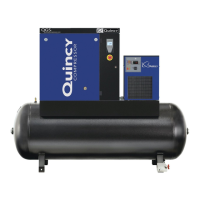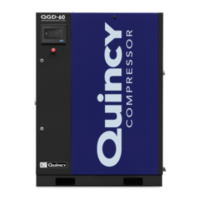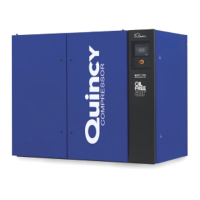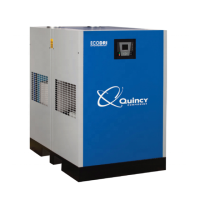a) REPORT DATE - The date that the compressor fluid
was analyzed.
b) REPORT NUMBER- The assigned number to this
report.
c) CUSTOMER ADDRESS- The name and address of
the person this report is being mailed to. This
information is taken from the sample bottle as it is
received.
d) CUSTOMER- The owner of the unit that the sample
came from.
e) COMPRESSOR MANUFACTURE- Brand of
compressor the sample is taken from.
f) COMPRESSOR FLUID TYPE- This should always
read QUINSYIW, QUINSYIW For QUINSW IV.
g) SERIAL NUMBER- The unit serial number of the
compressor the fluid sample was taken from.
h) MODEL NUMBER- The model number of the
compressor the compressor fluid sample was taken
from.
i) HOURS ON FLUID- These are the actual hours that
the QUINSW fluid has been in the unit since the
last compressor fluid change.
j) HOURS ON MACHINE - This is the total hours on
the compressor hourmeter.
k) SAMPLE DATE- The date that the sample was
taken from the compressor.
NOTE:
Items c - k are information provided by the service
person supplying the compressor fluid for analysis.
Incomplete or incorrect information will affect the
report’s accuracy.
1)EVALUATION- This is a brief statement made by
the technician performing the actual compressor fluid
analysis. This statement addresses the condition of
the compressor fluid and filter. This statement will
also note any problems that need attention.
m) PHYSICAL PROPERTIES RESULTS- Particle size
is measured in microns. See figure 6-2 for
parameters.
n) SPECTROCHEMICAL ANALYSIS- See figure 6-2
for parameters.
Comrwessor Air/Fluid Se~arator Element
(OMA 50/50H/60 Models]
The element is of one piece construction that coalesces
the fluid mist, as it passes through the filtering medi~
into droplets that fall to the bottom of the separator
element seating plate to be picked up by a scavenging
tube and returned to the compressor. Care must be
taken in handling the separator element to prevent it
from being damaged. The separator element is secured
into the air/fluid reservoir by a single hold down stud
and retaining plate. At the top of the separator element
is a “Grounding” tab that should make contact with the
element hold down plate. Torque on the element hold
down plate retaining nut is 85 in. lb., with lubricated
threads.
!JJANGER!
UNDER NO CIRCUMSTANCES SHOULD THE
“GROUNDING” TAB BE REMOVED FROM
THE AIWFLUID SEPARATOR ELEMENT. IF
DISCOVERED BROKEN, REPLACE THE
SEPARATOR ELEMENT.
!WARN~G!
Any denting of the airlfluid separator element
may destroy the effectiveness of the filtering
media and result in a very high carry over of
fluid. Never “OVER TORQUE” the separator
hold down plate.
Compressor Air/Fluid SeDarator Element
{Q
MA 75, 100, 125 and 150)
The element is of a one piece construction that
coalesces the fluid mist as it passes through the filtering
media, into droplets that fall to the bottom of the
separator element seating plate to be picked up by a
scavenging tube and returned to the compressor. Care
must be taken in handling the separator element to
prevent it from being damaged. The separator element
is secured into the air/fluid reservoir by two hold down
nuts and a retaining plate. Torque on the element hold
down plate retaining nuts are 85 in. lb., with lubricated
threads. The hold down plate provides ground contact
between the air/fluid separator element and the
compressor ground.
49

